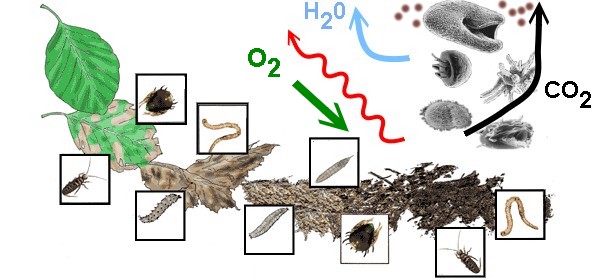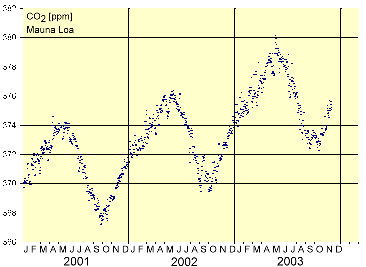|
|
 |
|
|
|
 |
 |
|
|
 |
Context
|
Key words:
photosynthesis, carbon cycle, assimilation, dissimilation, emissions from plants | |
|
 Carbon dioxide cycle Carbon dioxide cycle
We learned in our biology lessons about the process of photosynthesis. With the help of energy from the sun, plants convert carbon dioxide (CO2) and water (H2O) into organic biomolecules (glucose in the first step) and oxygen (O2). In order to grow plants also need some other compounds: minerals, phosphate, nitrate, etc. We show these additional compounds in the scheme below as brown dots. Most importantly: While plants grow, they take up CO2 and release O2.
|
 |
 |
|
1. a+b) Natural cycle of biomass formation and biomass degradation. The grey organisms in the lower picture are bacteria and soil microorganisms.
Scheme composed by: Elmar Uherek
|
|
At the same time biomass decomposes. We know that in autumn many trees lose their leaves. They fall to the ground. Small animals like insects, worms, larva and mites decompose and digest them. Humus is formed. Bacteria cause further decomposition (so called mineralisation) and produce carbon dioxide, water and some minerals. During decomposition energy is released, the organisms take up oxygen and release carbon dioxide as do we the larger animals. The cycle is closed.
|
Question: Can you attribute the terms "assimilation" and "dissimilation" to the schemes above? If you do not know them, look up in the Internet what they stand for. |
|
During the growing season nature takes up more carbon dioxide from the air than it releases. During the rest period more CO2 is released by decomposition than taken up by plants. The CO2 ratio in the air has a seasonal pattern. In the last century, the total amount of CO2 increased continuously, since humans also added CO2 from the combustion of coal, oil and natural gas. Most is added in winter during the heating period.
|
 |
 |
 |
|
2. Seasonal variation of the CO2 mixing ratio (in ppm) based on daily values for the years 2001 - 2003 as measured at the Mauna Loa observatory. Click on the image for a full view!
|
|
|
 Organic emissions and forest flavour Organic emissions and forest flavour
|
 |
 |
|
3. Emissions of gases from trees and the conversion of these gases into fine aerosol particles is probably the cause of the blueish haze over the Great Smoky Mountains (USA).
|
|
 |
Plants convert carbon dioxide and water into bio-molecules, build cells from molecules, leaves, wood and other tissue from cells. However, plants do not only release oxygen to the air in photosynthesis or carbon dioxide when they breathe. They also emit a wide range of organic chemicals in smaller amounts . The most abundant are isoprene (a small molecule containing 5 C-atoms) and terpenes. The latter are larger and form the basis for the flavour of the forest and many fruits and flowers. These compounds are emitted when light falls on the vegetation, when temperature increases and when plants are stressed (drought, injuries, infestation by parasites). The larger emitted molecules tend to form particles after oxidation.
|
|
 |
|







